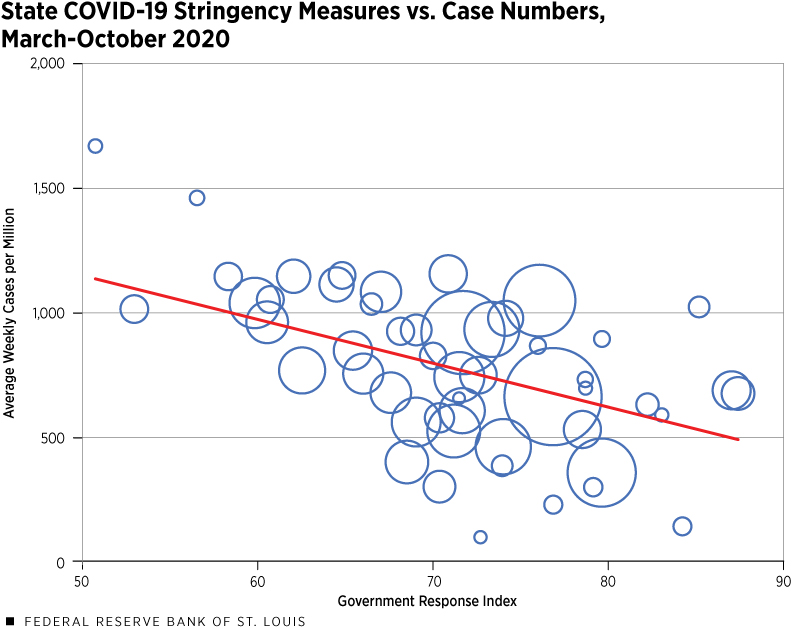How COVID-19 Containment Measures Affected Unemployment
During 2020, COVID-19 containment measures, such as stay-at-home orders and restrictions on certain businesses, had a noticeable effect on the U.S. unemployment rate, which peaked at 14.8% in April.
St. Louis Fed Economist Fernando Leibovici and Research Associate Matthew Famiglietti explored the extent to which these measures involved a trade-off between health and economic outcomes in a February article in the Regional Economist.
The authors looked at policy responses among states—such as the strictness of their containment measures—and how these policies affected health and economic outcomes. Leibovici and Famiglietti consulted data from the Oxford COVID-19 Government Response Tracker (OxCGRT) stringency policy index, which measures how restrictive states have been in closing schools and workplaces and shutting down public events and travel, among other things.
Containment Measures and Health Outcomes
The first step for the authors was examining the relationship between containment measures and health outcomes.
“We investigated whether states that were more willing to implement these measures also experienced a milder spread of the virus,” they wrote.
The figure below plots the relationship between each state’s maximum monthly stringency index between March and October 2020 and the average number of weekly cases per million inhabitants. The figure suggests that stricter containment measures were likely to have been effective in containing the spread of COVID-19, the authors noted.

SOURCES: OxCGRT and the Centers for Disease Control and Prevention.
NOTE: This figure plots the average number of weekly COVID-19 cases normalized by population in a state against the maximum stringency index from March 2020 to October 2020. States with stricter stringency measures experienced fewer coronavirus cases. (Calculations include the District of Columbia.)
Containment Measures and Economic Outcomes
The authors’ next step was examining the economic impact of virus containment measures; they did this by checking whether states with stricter measures saw a higher rise in unemployment. The second figure plots the relationship between each state’s maximum stringency index and the change in the state’s unemployment rate from March through October 2020.

SOURCES: Bureau of Labor Statistics and OxCGRT.
NOTE: This figure plots the maximum stringency index in a state against the change in the unemployment rate from March 2020 to October 2020. The positive relationship implies that states with stricter stringency measures experienced larger employment losses during this period. (Calculations include the District of Columbia.)
“We found that states more willing to undertake restrictive measures to control the pandemic also experienced a higher increase in the unemployment rate,” they wrote. “Thus, there does appear to be a trade-off between the economic and health outcomes caused by COVID-19 containment measures.”
But the figure conceals two distinct periods that unfolded during the pandemic. The first period (March to June 2020) showed a sharp increase in the unemployment rate; this period occurred when the virus was new and uncertainty was high, thus leading governments to take strong actions to shut down certain parts of the economy in order to slow the pandemic. The second (July to October 2020) showed a broad decline in unemployment as states reopened their economies.
Stringency Measures and Employment
The authors’ last step was to look at the relationship between containment measures and economic outcomes during these two periods. The third figure, consisting of two panels, plots the maximum stringency index against the change in the unemployment rate in each period.

SOURCES: Bureau of Labor Statistics and OxCGRT.
NOTE: This figure plots the maximum stringency index in a state against the change in the unemployment rate within two separate time windows. Early in the pandemic, stringency measures were correlated with employment loss, but later in 2020, labor markets with tougher stringency measures recovered more rapidly. (Calculations include the District of Columbia.)
The panel on the left shows that, between March and June 2020, states with stricter measures saw greater employment losses. The panel on the right shows that between July and October 2020, the opposite occurred; states with stricter containment measures saw sharper drops in the unemployment rate than those that were less restrictive.
The third figure suggests that while containment measures may have had a bigger economic impact in the short run, they might have permitted labor markets to recuperate quickly, frequently at a faster pace than states that were less stringent, the authors observed.
“This evidence suggests that the strict containment measures introduced to control the spread of COVID-19 might not hurt the economy in the long term; rather, these measures were associated with a lower spread of the virus and with a transitory short-term economic shock,” they wrote. “Our findings imply that if the relationship between the recovery and stringency measures holds, in the medium term, there might not be a tradeoff between the health and economic implications of these measures.”
Additional Resources
- Regional Economist: COVID-19 Containment Measures, Health and the Economy
- On the Economy: COVID-19’s Effects on Dual-Earner Households
- On the Economy: Labor Market Engagement and the Pandemic’s Impact on American Workers
Citation
ldquoHow COVID-19 Containment Measures Affected Unemployment,rdquo St. Louis Fed On the Economy, July 12, 2021.
This blog offers commentary, analysis and data from our economists and experts. Views expressed are not necessarily those of the St. Louis Fed or Federal Reserve System.
Email Us
All other blog-related questions

